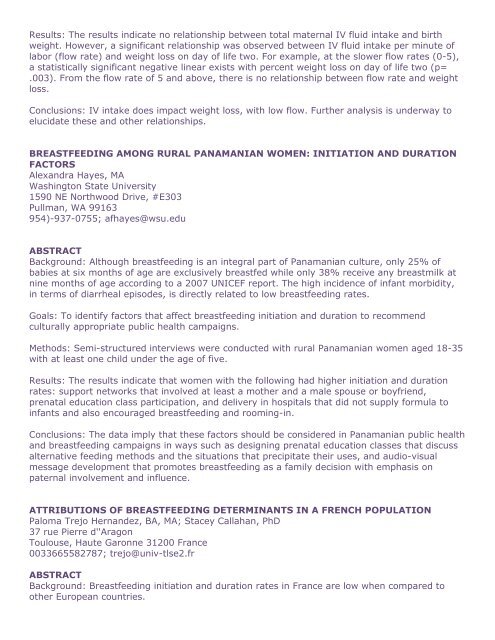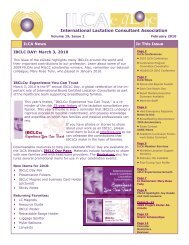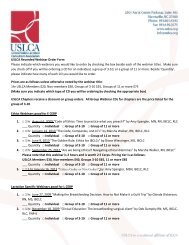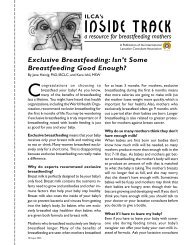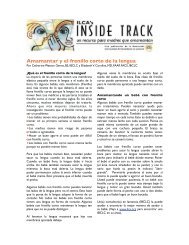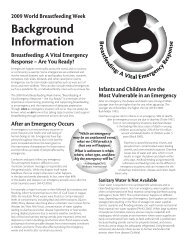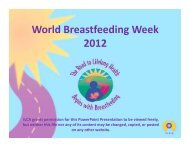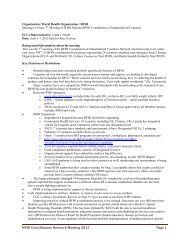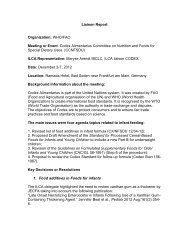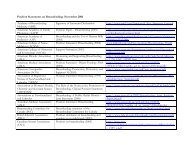2010 - International Lactation Consultant Association
2010 - International Lactation Consultant Association
2010 - International Lactation Consultant Association
Create successful ePaper yourself
Turn your PDF publications into a flip-book with our unique Google optimized e-Paper software.
Results: The results indicate no relationship between total maternal IV fluid intake and birth<br />
weight. However, a significant relationship was observed between IV fluid intake per minute of<br />
labor (flow rate) and weight loss on day of life two. For example, at the slower flow rates (0-5),<br />
a statistically significant negative linear exists with percent weight loss on day of life two (p=<br />
.003). From the flow rate of 5 and above, there is no relationship between flow rate and weight<br />
loss.<br />
Conclusions: IV intake does impact weight loss, with low flow. Further analysis is underway to<br />
elucidate these and other relationships.<br />
BREASTFEEDING AMONG RURAL PANAMANIAN WOMEN: INITIATION AND DURATION<br />
FACTORS<br />
Alexandra Hayes, MA<br />
Washington State University<br />
1590 NE Northwood Drive, #E303<br />
Pullman, WA 99163<br />
954)-937-0755; afhayes@wsu.edu<br />
ABSTRACT<br />
Background: Although breastfeeding is an integral part of Panamanian culture, only 25% of<br />
babies at six months of age are exclusively breastfed while only 38% receive any breastmilk at<br />
nine months of age according to a 2007 UNICEF report. The high incidence of infant morbidity,<br />
in terms of diarrheal episodes, is directly related to low breastfeeding rates.<br />
Goals: To identify factors that affect breastfeeding initiation and duration to recommend<br />
culturally appropriate public health campaigns.<br />
Methods: Semi-structured interviews were conducted with rural Panamanian women aged 18-35<br />
with at least one child under the age of five.<br />
Results: The results indicate that women with the following had higher initiation and duration<br />
rates: support networks that involved at least a mother and a male spouse or boyfriend,<br />
prenatal education class participation, and delivery in hospitals that did not supply formula to<br />
infants and also encouraged breastfeeding and rooming-in.<br />
Conclusions: The data imply that these factors should be considered in Panamanian public health<br />
and breastfeeding campaigns in ways such as designing prenatal education classes that discuss<br />
alternative feeding methods and the situations that precipitate their uses, and audio-visual<br />
message development that promotes breastfeeding as a family decision with emphasis on<br />
paternal involvement and influence.<br />
ATTRIBUTIONS OF BREASTFEEDING DETERMINANTS IN A FRENCH POPULATION<br />
Paloma Trejo Hernandez, BA, MA; Stacey Callahan, PhD<br />
37 rue Pierre d''Aragon<br />
Toulouse, Haute Garonne 31200 France<br />
0033665582787; trejo@univ-tlse2.fr<br />
ABSTRACT<br />
Background: Breastfeeding initiation and duration rates in France are low when compared to<br />
other European countries.


